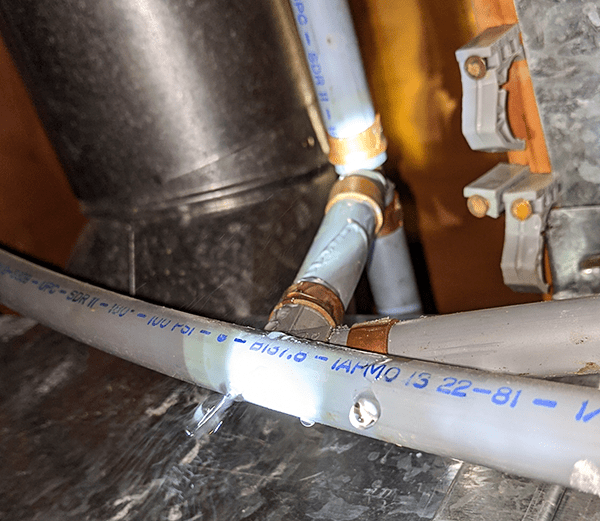As a metaphor for the year now ending, it was a little too on the nose. One Sunday morning a few weeks back we awoke to discover that the ferocious winds slamming Niagara had apparently carried into our happy home a demon seed, the fruit of which gestated to maturity overnight, the alien threatening to burst into our lives with who knew what consequences.
I refer you to the photo above, taken mid-cesarean.
Say what you may about the unpredictably standoffish staff at that Home Hardware down the way, they do mix a fine gallon of interior latex.
A tiny hole had formed at the bottom of what we’ll call the egg sac— just to prolong the metaphor for another sentence or two—and it was this that had clued us in to the creature’s presence. Unlike the shrieking and stomping that alerted Sigourney Weaver to her enemy, in pursuit of which, for some reason, she kept losing clothing, our demon’s signature sound was an irregular, but steady, steady, drip.
That’s what drew us downstairs (remaining fully clothed), first to the guest room, then to the furnace room, and finally to the bathroom. The floor shimmered under a shallow lake. A water pipe had sprung a leak. Several litres of water bulged from the ceiling, held back by nothing more than the impressive tensile strength of the aforementioned latex (three coats, five years ago).
The wind was blameless. It turned out the demon seed was actually planted 35 years earlier, when the house was built, and its name was polybutylene.
There’s a reasonable chance you have Poly-B's distinctive gray pipes in your house, too. Mixing metaphors in mid-leak, it’s a dripping time bomb.

Polybutylene piping was the first widely adopted form of plastic domestic plumbing, a cheaper alternative to copper that homebuilders—particularly on the lower end—started installing in the early ‘70s. Some 700,000 Canadian homes got stuck with the stuff before it was abandoned in the early ‘90s. By the mid-‘80s, when our definitely-not-high-end home was built, contractors and insurers had already realized that Poly-B was a slow-moving disaster. It had an unpleasant tendency to rot from the inside out, meaning it could look fine for decades and then on a Sunday morning in late November pop a pinhole leak and drench an innocent newspaper editor’s bathroom.
Our home inspector identified it as an item of concern when we made our offer on the place 11 years ago. I don’t remember his exact words, but his screaming departure from the basement clearly did nothing to dissuade us from going through with the deal. (Good thing, too. We sure as hell could never afford to move to this pricey corner of Canada now.)
At least two of our neighbours also battled the Poly-B menace. Right around this time seven or eight years ago we gathered for a Christmas drink and traded tales. One family had just replaced every pipe in their house, and another had done so years before. I didn’t quite scoff in my ignorance, but I wasn’t overly concerned. Our pipes looked fine! What do fraidy cat home inspectors know, anyway?
Now, a few thousand dollars later, we too have replaced every pipe in our house—hello PEX, the latest wonder plastic; goodbye discretionary spending, food will be enough. Two mask-wearing plumbers spent the better part of 12 hours hacking through drywall where it was unavoidable, and coming up with clever alternatives to avoid it where they could. While they were at it, they installed the “new” laundry tub that came with the house and sat collecting boots and garden tools and spiders for the last decade.
I’ve not bothered calling our insurance broker to see if there’s a claim to be made—although it’s tempting to give him the gift of a good holiday guffaw. No, like everything else about this bloody year, we’ll just take it in stride and manage as best we can. On the plus side, we got away with 11 leak-free years. And unlike in many homes, where slow seepage can go undetected for months or years behind drywall—leading to a real fungal horror show of mold and rotted framing—most of our Poly-B was visible in the basement.
Next up?
The roof. When you have four roofing contractors knocking on your door in as many weeks, offering condolences on the coming demise of your shingles and their ability to shield your family from the elements, you know you’d better start socking away some cash. But that’s a 2021 problem, and 2021 has to be better. Right?
May your holidays be free of demon aliens, viral or plastic—but maybe check those pipes in the basement anyway, just in case. ◆


